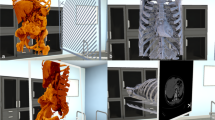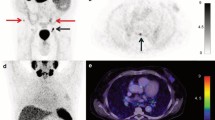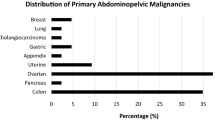Abstract
Purpose
Cinematic rendering (CR) is a method of photorealistic 3D visualization of volumetric imaging data. We applied this technique to fusion PET/CT data.
Methods
Two recent PET/CT cases were selected, one each of prostate-specific membrane antigen (PSMA)-targeted 18F-DCFPyL, and somatostatin-receptor-targeted 68 Ga-DOTATATE. Targeted radiotracers were selected in order to provide high-contrast images for this proof-of-principle study. Cinematic rendering was performed with an enhanced algorithm that incorporated internal lighting within the PET-avid organs and lesions to allow for a distinct visual signature.
Results
The use of internal lighting for PET data provided CR of fused PET/CT scans. The interpreting radiologist must make judicious use of presets and cut planes in order to ensure important findings are not missed.
Conclusions
CR of PET/CT data provides a photorealistic means of visualizing complex fusion imaging datasets. Such visualizations may aid anatomic understanding for surgical or procedural applications, may improve teaching of trainees, and may allow improved communication with patients.


Similar content being viewed by others
References
Rowe SP, Fishman EK (2019) Image processing from 2D to 3D In: Medical Radiology. 103–120. Springer Verlag
Johnson PT, Schneider R, Lugo-Fagundo C, Johnson MB, Fishman EK. MDCT angiography with 3D rendering: a novel cinematic rendering algorithm for enhanced anatomic detail. AJR Am J Roentgenol. 2017;209:309-312.
Fritz J, Ahlawat S. High-resolution three-dimensional and cinematic rendering MR neurography. Radiology. 2018;288:25.
Rowe SP, Chu LC, Recht HS, Lin CT, Fishman EK. Black-blood cinematic rendering: a new method for cardiac CT intraluminal visualization. J Cardiovasc Comput Tomogr. 2020;14:272-274.
Rowe SP, Chu LC, Fishman EK. Evaluation of stomach neoplasms with 3-dimensional computed tomography. J Comput Assist Tomogr. 2018;42:661-666.
Rowe SP, Fritz J, Fishman EK. CT evaluation of musculoskeletal trauma: initial experience with cinematic rendering. Emerg Radiol. 2018;25:93-101.
Elshafei M, Binder J, Baecker J, et al. Comparison of cinematic rendering and computed tomography for speed and comprehension of surgical anatomy. JAMA Surg. 2019;154:738-744.
Binder JS, Scholz M, Ellman S, et al. Cinematic rendering in anatomy: a crossover study comparing a novel 3D reconstruction technique to conventional computed tomography. Anat Sci Educ. 2021;14:22-31.
Comaniciu D, Engel K, Georgescu B, Mansi T. Shaping the future through innovations: from medical imaging to precision medicine. Med Image Anal. 2016;33:19–26.
Immel S, Cohen MF, Greenberg DP. A radiosity method for non-diffuse environments. SIGGRAPH. 1986;133-142.
Rowe SP. Artificial intelligence in molecular imaging: at the crossroads of revolutions in medical diagnosis. Ann Transl Med. 2021;9:817.
Solnes LB, Werner RA, Jones KM, et al. Theranostics: leveraging molecular imaging and therapy to impact patient management and secure the future of nuclear medicine. J Nucl Med. 2020;61:311-318.
Gehrsitz P, Rompel O, Schöber M, et al. Cinematic Rendering in Mixed-Reality Holograms: A New 3D Preoperative Planning Tool in Pediatric Heart Surgery. Front Cardiovasc Med. 2021;8:633611. Published 2021 Feb 9. doi:https://doi.org/10.3389/fcvm.2021.633611.
Rowe SP, Johnson PT, Fishman EK. Cinematic rendering of cardiac CT volumetric data: principles and initial observations. J Cardiovasc Comput Tomogr. 2018;12:56-59.
Author information
Authors and Affiliations
Corresponding author
Ethics declarations
Conflict of interest
EKF receives research support from Siemens Healthineers and GE Healthcare and is a co-founder and stockholder in HipGraphics, Inc. Under a license agreement between Progenics (a wholly-owned subsidiary of Lantheus) and the Johns Hopkins University, MGP and the University are entitled to royalties on an invention described in this article. This arrangement has been reviewed and approved by the Johns Hopkins University in accordance with its conflict of interest policies. SPR is a consultant for Progenics. RS and SK are employees of Siemens Healthineers. No other conflicts.
Additional information
Publisher's Note
Springer Nature remains neutral with regard to jurisdictional claims in published maps and institutional affiliations.
Rights and permissions
Springer Nature or its licensor holds exclusive rights to this article under a publishing agreement with the author(s) or other rightsholder(s); author self-archiving of the accepted manuscript version of this article is solely governed by the terms of such publishing agreement and applicable law.
About this article
Cite this article
Rowe, S.P., Pomper, M.G., Leal, J.P. et al. Photorealistic three-dimensional visualization of fusion datasets: cinematic rendering of PET/CT. Abdom Radiol 47, 3916–3920 (2022). https://doi.org/10.1007/s00261-022-03614-1
Received:
Revised:
Accepted:
Published:
Issue Date:
DOI: https://doi.org/10.1007/s00261-022-03614-1




